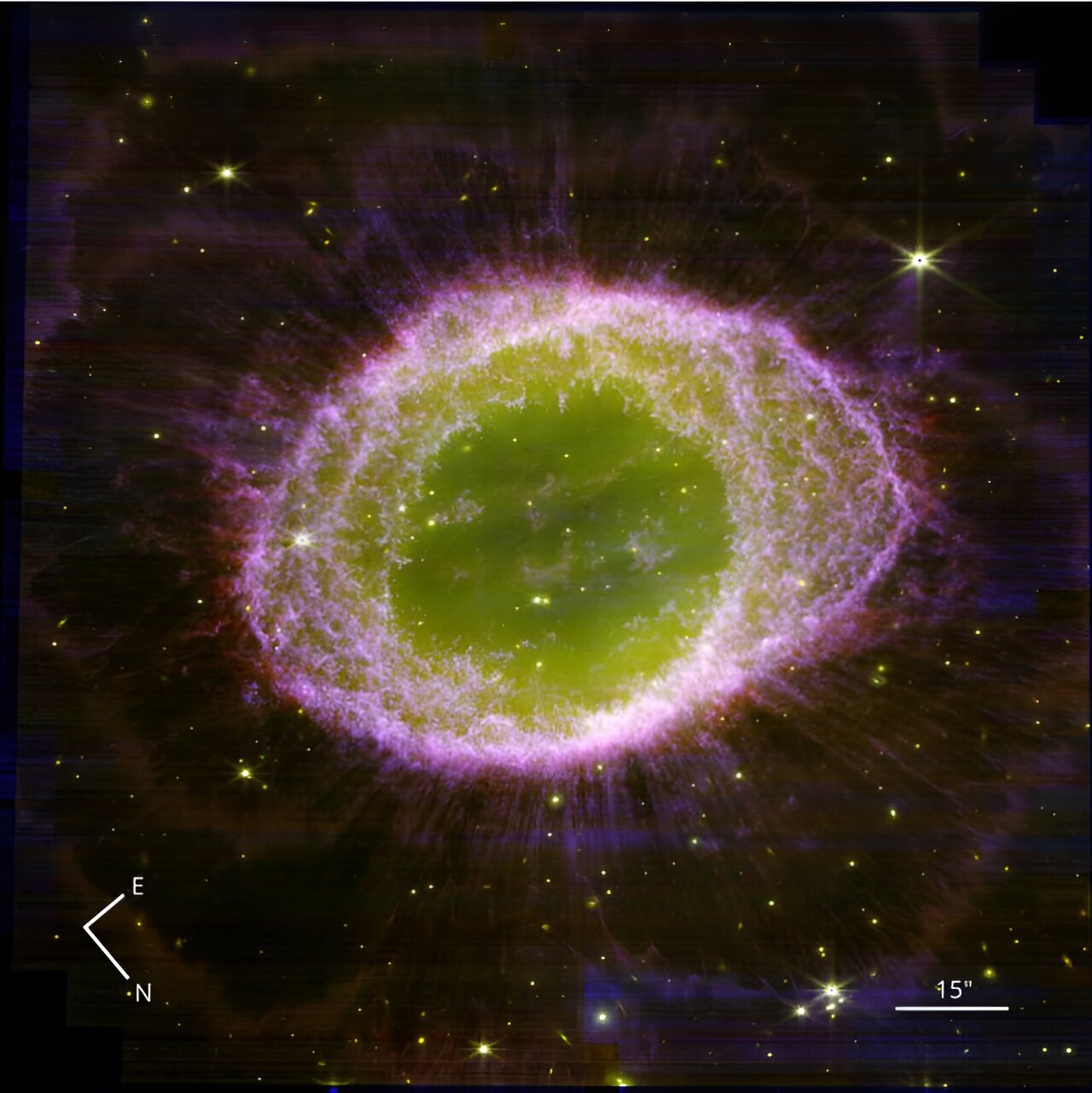An international team of astronomers has used the James Webb Space Telescope (JWST) to observe the planetary nebula NGC 6720, better known as the Ring Nebula. The observational campaign, described in a paper on the pre-print server arXiv, has revealed a wealth of structural detail in this nebula.
Planetary nebulae (PNe) are expanding shells of gas and dust that have been ejected from a star during the process of its evolution from a main sequence star into a red giant or white dwarf. They are relatively rare, but are important for astronomers studying the chemical evolution of stars and galaxies.
Located some 2,600 light years away from the Earth in the constellation of Lyra, the Ring Nebula is a well-known PN with a complex morphology. Its star is a white dwarf with a mass of at least 0.58 solar masses, effective temperature of 135,000 K and luminosity at a level of 310 solar luminosities. Previous observations have found that the white dwarf is currently in the phase of rapid fading and that the part of the ionized nebula is likely recombining.
In mid-2022, a group of astronomers led by Roger Wesson of Cardiff University, UK, observed the Ring Nebula with JWST, aiming to get more insights into its nature. The observations were carried out as part of the Cycle 1 General Observers (GO) program.
“We report here on JWST imaging of the Ring Nebula, NGC 6720, using 13 filters from 1.6 µm to 25µm,” the researchers wrote in the paper.
The images revealed that the Ring Nebula has an inner cavity and a shell in which some 20,000 dense clumps contain up to half the total mass. The imagery also unveiled the presence of a thin ring of possible polycyclic aromatic hydrocarbon (PAH) emission, and a halo that contains around 10 concentric arcs and 400 spikes.
By analyzing the obtained images, the astronomers found that the central cavity contains highly ionized gas and showcases two linear structures. In general, the cavity appears to have an approximately circular structure, with a radius of about 25 arcseconds. The shell surrounding this cavity is a broad region with a well-defined inner and outer edge, exhibiting an elliptical shape.
It turned out that the center of the Ring Nebula is offset by two arcseconds to the north-west from the central star. The astronomers suppose that such an offset may be caused by the original mass loss, the ionization and the hot stellar wind.
When it comes to the central star, JWST observations found that it is a triple system. Based on the images, the researchers found that the star has a binary companion at some 35 AU, and a distant, common proper motion companion at some 14,400 AU, which is assumed to be a low-mass M2–M4 main sequence star.
According to the authors of the paper, their findings confirm that PNe in general may contain a large variety of structures and phases, from highly ionized hot gas to dense molecular clumps.
More information:
R. Wesson et al, JWST observations of the Ring Nebula (NGC 6720): I. Imaging of the rings, globules, and arcs, arXiv (2023). DOI: 10.48550/arxiv.2308.09027
© 2023 Science X Network
Citation:
JWST observations explore the structure of the Ring Nebula (2023, August 29)
retrieved 29 August 2023
from https://phys.org/news/2023-08-jwst-explore-nebula.html
This document is subject to copyright. Apart from any fair dealing for the purpose of private study or research, no
part may be reproduced without the written permission. The content is provided for information purposes only.
Denial of responsibility! My Droll is an automatic aggregator of Global media. In each content, the hyperlink to the primary source is specified. All trademarks belong to their rightful owners, and all materials to their authors. For any complaint, please reach us at – [email protected]. We will take necessary action within 24 hours.


